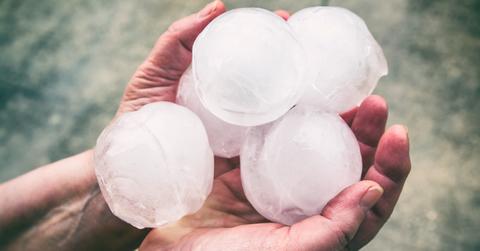Why Does It Hail in the Summer? Here Are the Main Reasons
Updated July 6 2020, 6:10 p.m. ET

According to a common misconception, hail is specific to winter weather. However, it frequently occurs during the summer in states like Nebraska, Colorado, and Wyoming. Countries like China, Russia, India, and Italy experience significant difficulties resulting from the disastrous impacts the natural phenomenon can have on infrastructure and the agricultural industry as well. But why does it hail in the summer?
So, why does it hail in the summer?
According to National Geographic, hail tends to occur when larger quantities of water freeze together over long periods of time in the cold upper regions of rainstorm clouds. Instead of a rain shower, the drops of water slowly but steadily accumulate into chunks of ice, or hailstones.

The hailstone continues to grow each time it hits drops of water — which will then freeze onto the surface of the hailstone. The process keeps on occurring until the rainstorm cloud gets too heavy, or until the updraft slows down or stops completely.
Some of these stones are perfectly smooth and symmetrical, while others are more irregular.
Hailstones are frequently confused with frozen rain, ice pellets, and sleet. However, it's worth bearing in mind that hail is the only one that falls to the ground frozen. Frozen rain is rain that transforms into ice once it's fallen down. Ice pellets occur once a snowflake has dissolved into the water while still in the cloud, and has fallen through sub-freezing conditions shortly afterward. Sleet is rain and snow mixed together.

While frozen rain and ice pellets are delicate, sleet and hail are anything but. The largest-ever hail in the world was recorded in Vivian, S.D., in 2010. According to CNN, it was 8 inches long and it weighed just under 2 pounds.
According to Matthew R. Kumjian, the associate professor of meteorology at Pennsylvania State University, and graduate student Rachel Gutierrez, Argentina could easily be the country where the largest hailstorm has ever taken place.
As the duo informed CNN, photographs taken after a particularly brutal storm with hailstones from 7.4 inches and all the way to 9.3 might allow the country to claim its place on the top of the charts.

As a previous article by Atlas Obscura reveals, hail can have disastrous effects that point far beyond broken window shields or damaged property.
In 2000, a Texas-native named Juan Oseguera lost his life after being hit in the head by a hailstone the size of a softball. Similar cases occurred in 1939 and 1928, the outlet notes.
And, in 1986, a hail storm caused an entire plane to crash near the Addison Airport in Dallas, Tex.
It's no wonder that most people respond to hail storms with confusion, fear, and dread.
"why does it sound like the hail is INSIDE MY BEDROOM," tweeted a person.
"what is this mess AND WHY DOES IT SCARE ME," wrote another person.
"After feeling sorry for myself and my wife worried for me after a bad hail storm on our farm, I noticed her tear up walking around looking at her garden, flowers, patio furniture etc destroyed and I just wanted to say don’t forget about your wife.." wrote someone else.